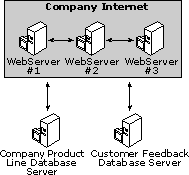Capacity Planning
|


|
Suggested Capacity Planning Methods
A transactional site has the potential for moderately heavy traffic, both outgoing and incoming, and requires more capacity at the outset than is required for either of the previous scenarios. Here are some guidelines:
- Put the initial Web server on a high-end platform.
- Examine the IIS 5.0 performance logs to determine how heavily used the serverís resources are. Focus on CPU utilization, ASP requests per second (if you are using ASP), and memory paging.
- Examine the IIS 5.0 server logs to determine the number of customer visits the site experienced.
- Examine the logs of the database server to determine the average and maximum numbers of database connections.
- Using the results of steps 2 and 3, plot out the growth metrics of the site. As with the marketing site, put special emphasis on periods when the site was more visible to customers than usual.
- As use of the Web serverís resources reaches approximately 70 percent, employ either content striping or specialization to add additional capacity to the site.
- Using the results of step 4, determine when the database server is close to bottlenecking either from additional customer database requests, or from database requests that have become more complex. Use more server resources, and segregate the database as necessary.
The model for a transactional site that has grown to accommodate increased traffic looks something like the one shown in the following figure:

© 1997-1999 Microsoft Corporation. All rights reserved.
